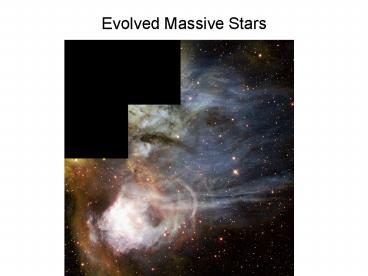Evolved Massive Stars - PowerPoint PPT Presentation
1 / 15
Title: Evolved Massive Stars
1
Evolved Massive Stars
2
Wolf-Rayet Stars
- Classification
- WNL - weak H, strong He, NIII,IV
- WN2-9 - He, N III,IV,V earliest types have
highest excitation - WC4-9 - He, C II,III,IV, O III,IV,V
- WO1-4 - C III,IV O IV,V,VI
- WN most common, WO least
3
Wolf-Rayet Stars
- log L/L? gt 5.5
- log Teff gt 4.7 (but ill defined - photosphere is
at different radii and Teff for different ?) - 10-6 - 10-4 M? yr-1
- vwind 1-4x103 km s-1
- 1/2 of kinetic energy in ISM within 3 kpc of
sun is from WR winds - Wind energy comparable to SN
4
Wolf-Rayet Stars
- Have lost H envelope - M gt 40 M? or binary with
envelope ejection - WNL ?WN?WC?WO is an evolutionary sequence and a
mass sequence - Mass loss first exposes CNO burning products -
mostly He,N - Next partial 3? burning - He, C, some O
- finally CO rich material
- Lowest mass stars end as WN, only most massive
become WO - Surrounded by ionized, low density wind-blown
bubble - Metallicity dependence for occurrence of WRs
- in Galaxy observed min mass for WR 35 M?
- in SMC min mass 70 M?
- WOs found only in metal-rich systems
5
Wolf-Rayet Stars
- High luminosities result in supereddington
luminosities in opacity bumps produced by Fe peak
elements at 70,000K and 250,000K - Without H envelope these temperatures occur near
surface - Radiative acceleration out to sonic point of wind
- Wind driven by continuum opacity instead of line
opacity - Photosphere lies in optically thick wind
6
Advanced Burning Stages
- No observations - these stages are so short that
they are completed faster than the thermal
adjustment time of the star - the stellar surface
doesnt know whats happening in the interior - Hydrodynamics may render the previous statement
untrue - For stars gt 8 M? C ignition occurs before
thermal pulse-like double shell burning - limits s-process to producing elements with A lt
90 - C burning and later (T gt 5e8 K) dominated are
neutrino cooled - energy carried by ?, not
photons - Near minimum mass C ignition is degenerate and
often off-center since ? cooling starting in core
- maximum T occurs outside core
7
Advanced Burning Stages
- C burning and later (T gt 5e8 K) dominated are
neutrino cooled - energy carried by ?, not
photons - When does ? cooling take over?
- at low T,? energy loss rate ??1.1x107T98 erg g-1
s-1 for T9 lt 6 ? lt 3x105 g cm-3 - ?? L/M 3.1x104S?/R erg g-1 s-1 after H
burning - set ?? ??
- rates equal for S? /R 1 at T9 0.62 S? /R
0.1 at T9 0.46
8
? cooling
- photons must diffuse, so rate of energy loss ?
?2T - ?s must traverse star, interacting with and
depositing energy in material - ?? R2N?/c ?1/3M2/3
- ?s are free streaming even in stellar
material interaction cross sections are small - cooling is local - ?s dont interact with star
to depositi energy before escaping - since ?s dont interact, they provide no
pressure support - Homework What does this imply about late burning
stages?
9
? cooling
- several paths for neutrino creation
- plasmon decay - plasma excitation decays into
? pair - photoneutrino process - ? pair replaces ? in
?-e- interaction - neutrino-nuclear bremsstrahlung - ?s of
breaking radiation - replaced by ? pairs
- At low T photoneutrino dominates, cooling/g
independent of ? - At higher T e-e annihilation dominates,
suppressed w/ increasing ? - At high ?, low T e- degeneracy inhibits pair
formation plasmon rate dominates - Overall rate increases w/ T
10
? cooling
11
? cooling
12
? cooling
- The URCA process - generating changes in neutron
excess and thereby heating cooling through mass
movements of material undergoing weak
interactions - rate of emission of energy by escaping
neutrinos/mole - If A 0 entropy decreases there is cooling
- A 0 if there is no composition change
13
? cooling
- If composition is changing
- for e- capture and ? decay w/ energy release Q
- if affinity is positive, e- capture (ec) is
driven to completion dYZ/dt is negative -
generates entropy - if affinity is negative, ? decay is driven to
completion dYZ/dt is positive - also generates
entropy
14
? cooling
- If conversion is slow, process is reversible and
no heat generated - If fast, degeneracy energy transferred into ?s
inefficient heat generated - depending on rate of ? cooling, heating or
cooling can occur - For fluid with mass motions (convection)
15
? cooling
- affinity will change with T,? as fluid moves, as
will S - More complications from nuclear excited states
- De-excitation releases ?s which heat material
- In convection or waves ?s may be deposited in
different place from capture or decay - net
energy transport - where the Urca pair are nuclei c d and ?c
?d are the rates of energy emission as
antineutrinos from ? decay of c and as neutrinos
from e- capture on d, respectively































